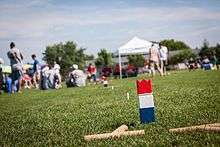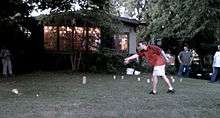Kubb
 2012 US National Championship in Eau Claire, WI | |
| Presence | |
|---|---|
| Olympic | Not yet |
| Paralympic | Not yet |

Kubb (pronounced [kɵb] in Swedish or [kub] in Gutnish) is a lawn game where the object is to knock over wooden blocks, known as kubbs, by throwing wooden batons at them, known as "kastpinnar." Kubb can be described perhaps as a combination of bowling and horseshoes.
Play takes place on a small rectangular playing field, known as a 'pitch'. 'Kubbs' are placed at both ends of the pitch, and the 'king', a larger wooden block, is placed in the middle of the pitch. Some rules vary from country to country and from region to region, but the ultimate object of the game is to knock over the 'kubbs' on the opposing side of the pitch, and then to knock over the 'king', before the opponent does. Games can last from five minutes to well over an hour. The game can be played on a variety of surfaces such as grass, sand, concrete, snow, or even ice.
The alleged Viking origin of the game has led some players and kubb fans to nickname the game “Viking chess”.
History
It is often claimed that the game dates back to the Viking Age and has survived since then on Gotland, although there is no evidence of this. The Föreningen Gutnisk Idrott ("Society (of) Gotland Games"), formed in 1912, does not list kubb as one of the traditional games from Gotland. The earliest mention of a kubb-like game comes from the second edition of the Swedish Encyclopedia “Nordisk familjebok” (the Nordic familybook) in 1911. It's there called "Kägelkrig" (Skittles war) and is described as a variation of Skittles and played with a ball. [1] The game in its modern conception became popular in the late 1980s when commercial kubb sets were first manufactured.
The key feature of the game (opposing teams throwing) is shared by the games kyykkä and bunnock, both of which come from Karelia or neighbouring areas. The game has now gained international interest, and an annual World Championship has been held since 1995 on Gotland. Large kubb tournaments now occur throughout Europe and the United States of America. Belgium alone held over 50 tournaments in 2012.
On December 13, 2011, Eau Claire, Wisconsin declared itself to be the 'Kubb Capital of North America'.[2] The city has hosted the U.S. National Kubb Championship since 2007, and is home to Kubbnation Magazine and many clubs and leagues, including the Eau Claire Kubb League, which is the largest weekly kubb league in the world. In addition, kubb sets are in the local schools, with some schools having kubb units in physical education classes and kubb clubs.
Game pieces
There are typically twenty-three game pieces used in kubb:[3]
- Ten kubbs, rectangular wooden blocks 15 cm tall and 7 cm square on the end.
- One king, a larger wooden piece 30 cm tall and 9 cm square on the end, sometimes adorned with a crown design on the top.
- Six batons, 30 cm long and 4.4 cm in diameter.
- Six field marking pins, four to designate the corners of the pitch, and two to mark the centreline.
Setup
According to the US Championship Rules and World Championship Rules, kubb is played on a rectangular pitch 5 metres by 8 metres. Corner stakes are placed so that a rectangle is formed. The center stakes are placed in the middle of the sidelines (long edges of the rectangle), which divides the pitch into two halves. No other markers are required to demarcate the field's boundaries, although markings that do not interfere with game play are allowed (such as chalk lines). The king is placed upright in the center of the pitch, and the kubbs are placed on the baselines (short edges of the rectangle), five kubbs on each side equidistant from each other. Kubbs starting the game on the baseline are referred to as base kubbs. The baseline should run through the center of the kubbs.[4] For young children, the 8-meter pitch length can be shortened.
Rulesets
Two official tournament rulesets available for kubb are the World Championship Rules and the U.S. National Championship Rules.
U.S. National Championship Rules
Play overview
Kubb is played between two teams, which may consist of only one person per team.
There are two phases for each team's turn:
- Team A throws the six batons (called Kastpinne/Kastpinnar in Swedish) from their baseline, at their opponent's lined-up kubbs (called Baseline kubbs). Throws must be under-handed, and the batons must spin end over end. Throwing batons overhand, sideways or spinning them side-to-side (helicopter) is not allowed.
- Kubbs that are successfully knocked down by Team A are then thrown by Team B onto Team A's half of the pitch, and stood on end. These newly thrown kubbs are called field kubbs. The key objective is to keep them close to each other (as to be able to hit more than one with a single throw of the pinnar). The player that tosses the kubbs is called the inkastare.
If a kubb is thrown out of play, i.e., outside the boundary markers or not beyond the middle line (Note: after being raised, at least half of the kubb must be in the field of play to be considered in play), then one more attempt is given. If this also goes out, the kubb becomes a "punishment kubb" and can be placed anywhere in the target half by the opposing team as long as it is at least one baton length from a corner marker or the King. If a thrown kubb knocks over an existing baseline or field kubb, then the field kubbs are raised at the location where they rest, and baseline kubbs are raised at their original location.
Play then changes hands, and Team B throws the batons at Team A's kubbs, but must first knock down any standing field kubbs. If a baseline kubb is knocked down before all remaining field kubbs, the baseline kubb is returned to its upright position. (Field kubbs that right themselves due to the momentum of the impact are considered knocked down. Also kubbs are considered knocked down if they end up tilting and relying on a game piece for support.) Again, all kubbs that are knocked down are thrown back over onto the opposite half of the field and then stood.
If either team does not knock down all field kubbs before their turn is over, the kubb closest to the centerline now represents the opposite team's baseline, and throwers may step up to that line to throw at their opponent's kubbs. This rule applies only to throwing the batons at the opposite team's field and baseline kubbs; fallen kubbs are thrown from the original baseline, as are attempts to knock over the king.
Play continues in this fashion until a team is able to knock down all kubbs on one side, from both the field and the baseline. If that team still has batons left to throw, they now attempt to knock over the king. If a thrower successfully topples the king, his team has won the game.
If at any time during the game the king is knocked down by a baton or kubb, the throwing team immediately loses the game.
In tournaments, winners are typically determined by playing best out of three.
For informal play between players of widely differing abilities, such as an adult and a child, it is permissible to shorten the length of the pitch. Another option is for both players to play on the same team and keep switching sides during play.

Tournaments

The Kubb World Championship[5] is held annually on the island of Gotland, Sweden. The U.S. Championship is held annually in Eau Claire, WI.
Tournaments in the U.S. have exploded since 2007, especially in the Midwest. In 2016, the U.S. tournament list includes over 40 tournaments. The majority of tournaments are located in Minnesota and Wisconsin. Tournament List
In 2013, the U.S. Midwest Championship was re-introduced. The annual tournament travels throughout the Midwest. (2013: Rockford, IL; 2014: Decorah, IA; 2015: Madison, WI; 2016: Madison, WI)
There are numerous tournaments throughout Europe (Sweden, Germany, Switzerland, Belgium, The Netherlands, Czech Republic, Italy and more). Most countries have their own national championship tournament.
Kubb Tournaments in other States:
References
- ↑ http://runeberg.org/nfbo/0293.html
- ↑ Paulus, Mike. "Welcome to the "Kubb Capital of North America"". Retrieved 8 September 2016.
- ↑ Kubb World Championship rules at VMKubb
- ↑ "U.S. Nationals Rules" (PDF). U.S. National Kubb Championship. Retrieved 17 February 2012.
- ↑ World championship
External links
- Kubb-Wikiportal
- U.S. National Kubb Championship
- Wikingerschach (German)
- Canadian Kubb Information.
- UK Kubb Information.
- TossingGames.com